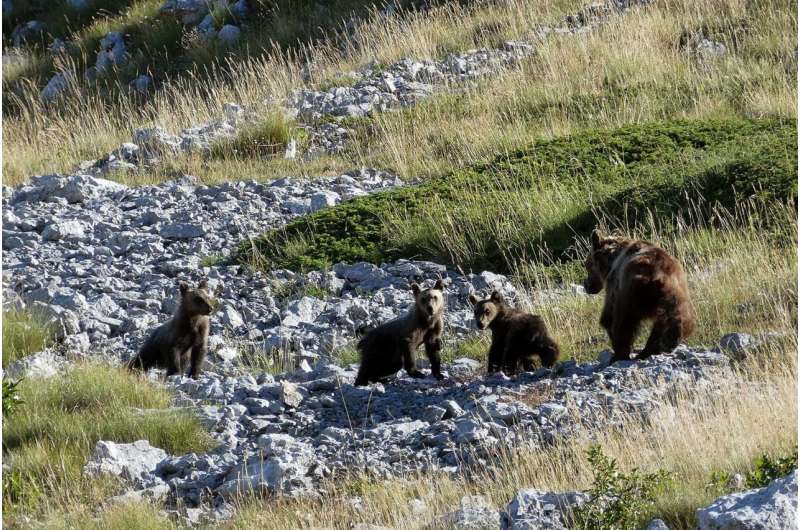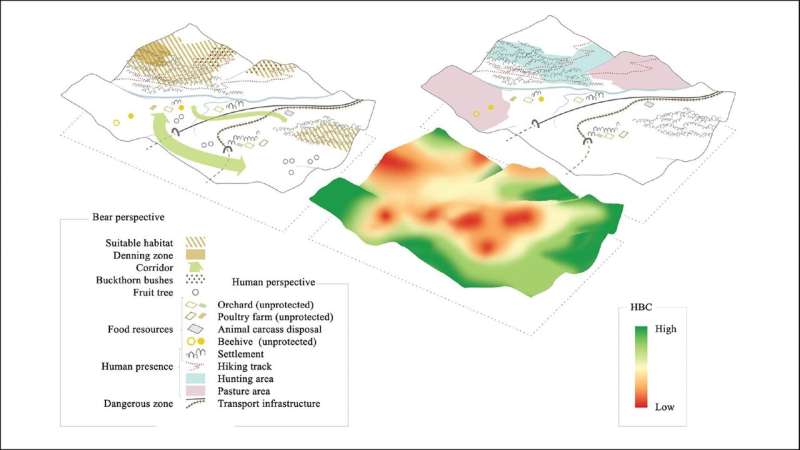This article has been reviewed according to Science X's editorial process and policies. Editors have highlighted the following attributes while ensuring the content's credibility:
fact-checked
trusted source
proofread
Bear–human coexistence reconsidered

The media uproar over wolf attacks on livestock in Switzerland and a bear attack in Italy show how charged the issue of large carnivores and humans coexisting in Europe is. ETH Zurich researcher Paula Mayer has now created a participatory model to help facilitate human-bear coexistence using the example of the Apennine brown bear.
Less than two hours' drive from the metropolis of Rome, bears still roam the woods. The Marsican or Apennine brown bears, a subspecies of the European brown bear, currently number about 70. For now. Thanks to improved protection, educational work and measures to prevent the damage these animals sometimes cause, this population has survived and has even increased slightly in recent times.
But the endangered bears still perish on highways or die from poison bait laid out by truffle hunters for their competitors' truffle-sniffing dogs. And not everywhere in their home range do people sympathize with the large carnivores.
Map identifies coexistence areas
For this reason, Paula Mayer came up with the idea of creating a model for the coexistence of humans and bears in the Abruzzo, Lazio and Molise National Park region and plotting it on a map in her Master's thesis.
This map is intended to support those involved at the local level—authorities, conservationists, farmers and tourism specialists—in identifying areas and measures that should be prioritized to promote human-bear coexistence.
"This project is an attempt to take a rational look at the landscape and figure out where and under what circumstances humans and large carnivores successfully coexist and where they don't," Mayer explains. Her supervisor, ETH Zurich Professor Adrienne Grêt-Régamey, encouraged Mayer to turn the methodology of her work into a scientific publication, which has just been published in the Journal for Nature Conservation.
Twenty-one municipalities evaluated
Mayer used her model to create maps for a total of 21 municipalities located in and around the Abruzzo National Park. As examples, she selected three municipalities and analyzed them in more detail.
While one municipality has a positive attitude towards the large carnivores, making bear-human coexistence very likely possible there, peaceful coexistence is rather unlikely in another of the municipalities surveyed. "It depends on things like whether the people in the municipality have been in contact with bears for a long time, or whether they know these animals only from hearsay." Mayer says she was surprised that in some cases municipalities just a few kilometers apart often had different opinions about the bears. This is mostly because of individual opinion makers who spread (false) information, she explains.
The question of coexistence also depends on whether the people in a given municipality rely on their own agricultural products or earn their living in tourism or away from home. "Tourism-reliant municipalities even stand to benefit from the bears, since wildlife tourism is booming in the Abruzzo National Park." Money is also being invested to make the local waste disposal, fruit crops and livestock bear-proof. The situation is different in rural municipalities, where preventive protection measures often lag behind. "If you own only ten sheep and a bear kills one of them, you feel your livelihood is threatened," Mayer says.

A global problem
Mayer believes that the "large carnivore problem" is the same everywhere. She says it's mostly an urban-rural conflict charged with emotion, and with a lot of symbolism projected onto the animals. "But it's more about interpersonal issues and control; the wild animals only serve a symbolic function."
The question, Mayer adds, is what measures are needed on the ground so that bear-human coexistence can succeed. One important factor that emerged from interviews with locals is that they want government compensation payments to be disbursed more quickly and with less red tape—or indeed for the government to actually make such payments in the first place. "Some people are angry because they've never been compensated for any damage caused by individual bears, despite promises to the contrary."
A practical tool
The model and generated coexistence maps constitute a practical tool, for example for examining how bear-human coexistence in the landscape changes over time. It can also be used to test whether measures are effective at the local level.
"If the model produces a map that shows areas of low coexistence despite measures like fences to protect beehives from bears, you can infer how effective a measure is—and whether other measures might be better for promoting coexistence in that location," Mayer says. "That's something we can assess very well—or even predict—with the model."
And it doesn't take a powerful mainframe computer to generate these maps either: the current maps were made on Mayer's laptop.
Network with many nodes
Mayer used a Bayesian network to approach this multi-layered problem. Such networks operate with conditional probabilities and can take into account and connect a variety of different factors. The model approach considers factors that both represent the human perspective and reflect the needs of the bears. These variables can be updated with explicit local information. To obtain this information, she worked with experts from nature conservation, tourism and research and conducted interviews with local people.
The bears' perspective is represented by factors such as suitable habitats, migration corridors and whether attractive human-made food resources are present. The latter include waste disposal facilities, orchards and livestock that aren't bear-proof. This affects the probability of bears appearing in and around settlements.
The model also considers threats to bears, such as unfenced sections of roads and railways or areas with a lot of tourist disturbance. The human perspective is influenced by network nodes such as different types of agriculture, hunting and truffle collecting as well as by local policies, damage compensation, knowledge and emotions regarding the bears.
To generate a map, the model links all these nodes and factors them in. This map shows the areas where human-bear coexistence works best. These are zones where people's tolerance is high and living conditions for bears are good. But it also shows areas where conditions are worse. "This model lends itself very well to mapping the complex web of interdependencies that underlie the coexistence of large carnivores and humans," Mayer says.
Moreover, the network nodes can be expanded as needed: in other contexts, nodes can be removed and replaced or new ones added. This makes it relatively easy to adapt and tailor the model to other cases—for example, to other regions or animal species such as wolves. "It is crucial to work with the people on the ground to incorporate the specific information from the local context into the model," explains the researcher.
Mayer came across this topic during an internship that was part of her Environmental Sciences study program at ETH Zurich. She worked for the conservation organization Rewilding Apennines in a project that aims to promote the coexistence of humans and the Marsican brown bear and other wildlife in the Central Apennines.
More information: Paula Mayer et al, Mapping human- and bear-centered perspectives on coexistence using a participatory Bayesian framework, Journal for Nature Conservation (2023). DOI: 10.1016/j.jnc.2023.126387
Provided by ETH Zurich





















